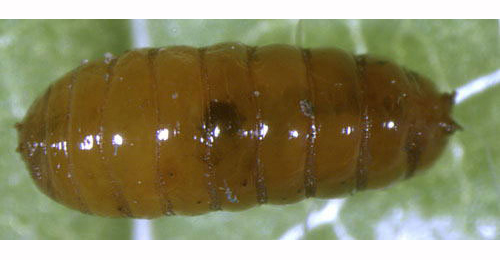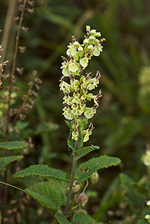|
||||||
|
TEUCRIUM. Germanders. [Lamiaceae] |
|
|
Eight species of Teucrium are recorded in Britain. These include the native Cut-leaved Germander (T. botrys), Water Germander (T. scordium), Wood Sage (T. scorodonia) and Wall Germander (T. chamaedrys). Cut-leaved Germander (T. botrys) and Water Germander (T. scordium) are protected under Schedule 8 of the Wildlife and Countryside Act, 1981. Five British miners are recorded on Teucrium. The tortricid Cnephasia conspersana is recorded as a seed / shoot-feeder on Teucrium in Britain A key to the European miners recorded on Teucrium is provided in Bladmineerders van Europa. |
|
Key for the identification of the known mines of British |
Note: Diptera larvae may live in a corridor mine, a corridor-blotch mine, or a blotch mine, but never in a case, a rolled or folded leaf, a tentiform mine or sandwiched between two more or less circular leaf sections in later instars. Pupation never in a cocoon. All mining Diptera larvae are leg-less maggots without a head capsule (see examples). They never have thoracic or abdominal legs. They do not have chewing mouthparts, although they do have a characteristic cephalo-pharyngeal skeleton (see examples), usually visible internally through the body wall. The larvae lie on their sides within the mine and use their pick-like mouthparts to feed on plant tissue. In some corridor miners frass may lie in two rows on alternate sides of the mine. In order to vacate the mine the fully grown larva cuts an exit slit, which is usually semi-circular (see Liriomyza huidobrensis video). The pupa is formed within the hardened last larval skin or puparium and as a result sheaths enclosing head appendages, wings and legs are not visible externally (see examples). See Key to non-Diptera. |
1a > Leaf-miner: A distinctive mine primarily above mid-rib, with irregular short lateral offshoots into leaf blade. Pupation external (Spencer, 1972: 51 (fig. 172), 55; Spencer, 1976: 270, 271 (fig. 486)). Branched, whitish, upper-surface corridor; main axis overlying the midrib; side branches overlying the main lateral veins. (In Campanula and Phyteuma the mine is much less branched, sometimes nothing more than a corridor on top of the midrib). Frass in rather long strings. Usually the mines begins as a long and narrow, shallow, tortuous lower-surface corridor that ends upon the midrib but otherwise is not associated with the leaf venation. Often this initial corridor is filled with callus, and then even less conspicuous. Pupation outside the mine. A linear mine on the upper surface, usually following the midrib and showing side branches along the veins. The frass is in strings. |
|
Liriomyza strigata (Meigen, 1830) [Diptera: Agromyzidae]. |
1b > Leaf-miner: A linear-blotch mine, first instar mine is linear, later developing into a conspicuous white blotch. Frass greenish diffused (Spencer, 1972b: 46, 47 (fig. 138); Spencer, 1976: 166). The mine begins with a long, upper-surface, slender corridor. After a moult the larva changes its behaviour, and makes a large, upper-surface primary blotch without apparent feeding lines. Often the blotch overruns more or less the initial corridor. Frass in the corridor liquified to form a wide green band, with a few tiny black granules along the sides. Pupation outside the mine. A narrow gallery leading to a largish blotch on the upper surface. Frass is green and indistinct in the gallery - small grains may be seen at the gallery edge. |
 Amauromyza labiatarum puparium Image: © Willem Ellis (Bladmineerders van Europa) |
|
Amauromyza labiatarum (Hendel, 1920) [Diptera: Agromyzidae]. |
|
Key for the identification of the known mines of British |
Note: The larvae of mining Coleoptera, Hymenoptera and Lepidoptera may live in a corridor mine, a corridor-blotch mine, a blotch mine, a case, a rolled or folded leaf, a tentiform mine or sandwiched between two more or less circular leaf sections in later instars. Larva may pupate in a silk cocoon. The larva may have six legs (although they may be reduced or absent), a head capsule and chewing mouthparts with opposable mandibles (see video of a gracillarid larva feeding). Larvae of Hymenoptera and Lepidoptera usually also have abdominal legs (see examples). Frass, if present, never in two rows. Unless feeding externally from within a case the larva usually vacates the mine by chewing an exit hole. Pupa with visible head appendages, wings and legs which lie in sheaths (see examples). |
1a > Leaf-miner: Rather long corridor winding through the leaf, regularly crossing itself. The corridor later widens considerably. Frass normally in a narrow central line, but may also lie along the side, or be absent. The larva regularly leaves a mine and restarts elsewhere. |
|
| Apteropeda globosa (Illiger, 1794) [Coleoptera: Chrysomelidae]. |
1b > Leaf-miner: Rather long full depth corridor that winds freely through the leaf and may cross itself. In the end the corridor widens considerably. Frass mostly in a narrow central line, but may also be deposited along the sides or be missing. The larvae regular leave a mine to restart elsewhere. Pupation outside the mine. Neither larva or mine can be distinguished from that of related species. |
|
Apteropeda orbiculata (Marsham, 1802) [Coleoptera: Chrysomelidae]. |
1c > Leaf-miner: In the first instar the larva mines the leaves, forming short, irregular, blotch-like mines, but in later instars it lives externally, feeding in spun leaves and often twisting those of tender shoots. Larval head light-brown or yellowish brown, edged with black postero-laterally, ocellar area blackish; prothoracic plate black edged with whitish anteriorly; abdomen dull dark green; pinacula distinct, black, sometimes brownish but with black bases to setae; anal plate large, black (Bradley et al., 1973). Small, full depth mine without a definite shape; little frass. Some silk is deposited in the mine. The larva soon leaves the mine and continues feeding among spun leaves. |
|
Cnephasia incertana (Treitschke, 1835) [Lepidoptera: Tortricidae]. |
| Last updated 30-Jan-2018 Brian Pitkin | ||

